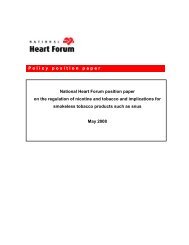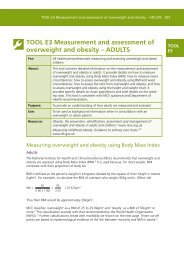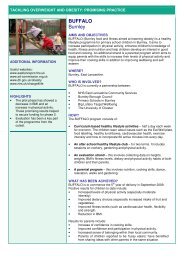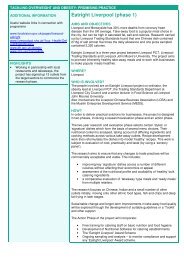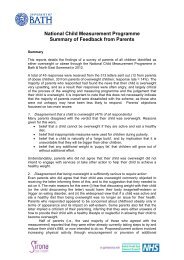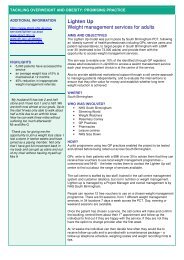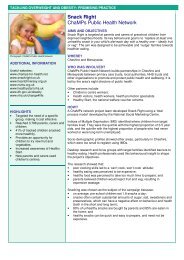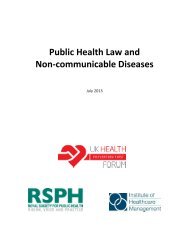The Challenge of Non-Communicable Diseases and Road Traffic ...
The Challenge of Non-Communicable Diseases and Road Traffic ...
The Challenge of Non-Communicable Diseases and Road Traffic ...
Create successful ePaper yourself
Turn your PDF publications into a flip-book with our unique Google optimized e-Paper software.
An Overview 63<br />
Guidelines <strong>and</strong> Quality <strong>of</strong> Care<br />
Support for decision making by health care pr<strong>of</strong>essionals<br />
in the form <strong>of</strong> evidence-based guidelines<br />
<strong>and</strong> other educational materials, educational meetings,<br />
audit, <strong>and</strong> feedback, improve their adherence<br />
to disease management guidelines <strong>and</strong> st<strong>and</strong>ardized<br />
case management, <strong>and</strong> improve patient outcomes<br />
[421]. High-quality drugs need to be procured <strong>and</strong><br />
supplied at low prices <strong>and</strong> equipment upgraded <strong>and</strong><br />
available. Successful implementation <strong>of</strong> guidelines<br />
requires wide distribution, training, <strong>and</strong> supervision<br />
<strong>of</strong> health workers, <strong>and</strong> evaluation in practice with<br />
appropriate quality or care <strong>and</strong> outcome measures<br />
[118]; this is not straightforward, given the shortages<br />
<strong>of</strong> health workers <strong>and</strong> funding <strong>and</strong> the organization<br />
needed. Nevertheless, the use <strong>of</strong> clinical<br />
guidelines as tools for linking allocative efficiency<br />
with the practice <strong>of</strong> care has already been discussed<br />
in Section 5.5 on ‘Health Financing’.<br />
Using models familiar from communicable disease<br />
care has been proposed for strengthening performance<br />
management [435]; <strong>and</strong> lessons learnt<br />
from efforts to improve quality <strong>of</strong> HIV/AIDS care<br />
may be applicable to promoting quality <strong>of</strong> care <strong>of</strong><br />
those with NCDs. Elements include the number <strong>and</strong><br />
mix <strong>of</strong> health staff, clinician performance, a safe <strong>and</strong><br />
well-equipped health care environment, diagnostic<br />
support, <strong>and</strong> reliable drug supply [436].<br />
Diagnosis <strong>and</strong> management <strong>of</strong> disease can be frustrated<br />
by the paucity or quality <strong>of</strong> equipment. Measurement<br />
<strong>of</strong> lung function or hypertension using<br />
simple <strong>and</strong> inexpensive methods can be a major issue<br />
for diagnosis <strong>and</strong> management <strong>of</strong> disease, given<br />
the limited access to spirometry <strong>and</strong> sphygmomanometers<br />
[51] for example. Adaptation <strong>of</strong> guidelines<br />
for use in low-resource settings to avoid dependence<br />
on laboratory measurement has been referred to already<br />
in relation to CVD risk assessment [308].<br />
Efforts to scale up interventions for chronic diseases<br />
still tend to focus on individual diseases [349]<br />
or use a single disease guideline as a starting point<br />
[147]. This approach is likely to be unaffordable <strong>and</strong><br />
unsustainable as populations age [215]. It risks confronting<br />
front-line health workers <strong>and</strong> patients with<br />
multiple disease management frameworks, which<br />
may be unworkable in practice for patients with<br />
multiple co-morbidities [437], <strong>and</strong> runs contrary to<br />
patient-centered care.<br />
Self-Management <strong>and</strong> Patient-Centered Care<br />
For developing countries, team-work <strong>and</strong> patient<br />
partnership may be as important as adequate funding<br />
[438]. Apart from the organization <strong>and</strong> quality <strong>of</strong><br />
care, it can be a significant challenge in some settings<br />
to enable patients to underst<strong>and</strong> the choices they<br />
have, <strong>and</strong> to make informed decisions, as well as to<br />
support patient compliance <strong>and</strong> active participation<br />
in treatment.<br />
Supporting patient self-management is worthwhile,<br />
central to good outcomes <strong>of</strong> NCD treatment,<br />
<strong>and</strong> has the potential to alleviate pressure on health<br />
<strong>and</strong> social services [439], especially given that people<br />
with long-term conditions manage these most<br />
<strong>of</strong> the time by themselves or with family members.<br />
Self-management support, particularly patient education<br />
about their condition <strong>and</strong> care <strong>and</strong> motivational<br />
counseling, improves patient adherence to<br />
treatments <strong>and</strong> outcomes, service use <strong>and</strong> satisfaction,<br />
<strong>and</strong> knowledge <strong>of</strong> their disease [421]. Patientcentered,<br />
self-management support is already provided<br />
to PLWH in Africa although its quality may<br />
vary [422]. An example <strong>of</strong> how patient self-management<br />
for HIV has been implemented <strong>and</strong> extended<br />
to cover other risk factors is given in Box 13.<br />
Supporting self-management is likely to work best<br />
as part <strong>of</strong> a wider initiative to improve care which<br />
also includes education <strong>of</strong> practitioners, effective use<br />
<strong>of</strong> evidence <strong>and</strong> technology , decision aids, <strong>and</strong> community<br />
partnerships [439]. Information provision<br />
alone is unlikely to be enough, <strong>and</strong> different clinical<br />
conditions may need varying approaches according<br />
to the self-care activities required. <strong>The</strong>re is emerging<br />
evidence that strategies co-created by pr<strong>of</strong>essionals<br />
<strong>and</strong> service users have positive outcomes [440].<br />
Given the limited health service resources in<br />
low-income countries, ‘full self-management’, with<br />
the patient as the hub <strong>of</strong> disease management, supported<br />
by smart phone technology, peer support,<br />
<strong>and</strong> other resources such as primary care providers<br />
<strong>and</strong> informal care givers, has been proposed as an<br />
alternative to models <strong>of</strong> chronic care that are more<br />
provider-centered [441].



